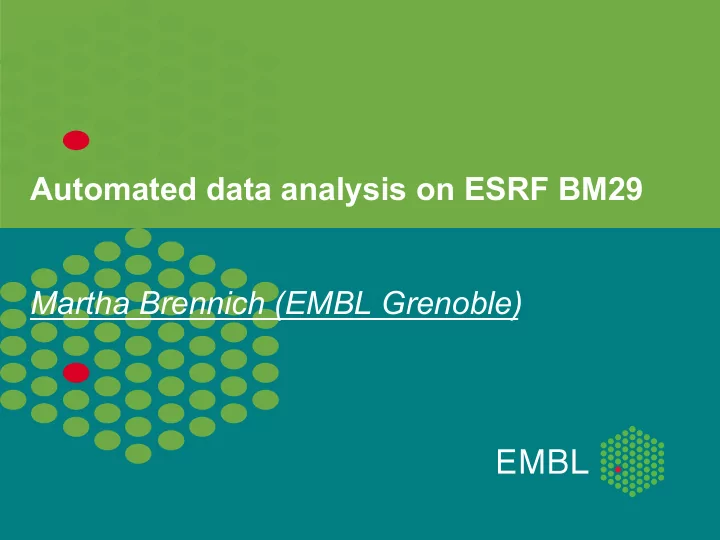

Automated data analysis on ESRF BM29 Martha Brennich (EMBL Grenoble)
Idealized bio-SAS experiment Solution Scattering Data from Protein of Interest Black Box Neutron source/beamline homesource
What can we learn from BioSAXS? • Low-resolution structural information – shape, overall fold • Mean molecular weight, oligomeric state • Mixing ratios • Model validation ? • Domain placement • Complex structures • Ab-initio models • …
• Dedicated solution scattering beamline • Optimized for macromolecules (4kDa -1MDa) • Many “non-expert” users, short visits
Automated sample Handling
Inline HPLC detector 3 m capillary x-rays sample changer
sample changer
Automated data acquisition About 3 minutes per buffer/sample/buffer set Actual acquisition rate: 10 frames/minute
ISPyB: Prepare your acquisition from anywhere! ISPyB: Information System for Protein CrystallographY Beamlines
Data Processing - EDNA 1 2 x 10 Select Subtract pyFai Average 10 autorg dammif damaver datgnom dammin
Data Processing - EDNA Image 1D data Curve Curve Processing reduction reduction Analysis Group all Compare AutoRg Radial protein buffers Integration curves from to determine PyFAI same the "Best" construct DATGNOM Frame Subtract merging and "Best" Buffer Compare Radition from protein curves damage DAMMIF curve detection Idealized curve Ab-initio Models 1D curve Protein Curve Indication of quality Model independent Parameters (similarity of all curves)
ISPYB: Data Analysis Overview
ISPYB: 1d Visualisation
ISPYB: Model Visualistation
Inline HPLC x-rays sample changer
In-Situ HPLC – increase sample monodispersity automatic valve column not controlled by beamline capillary from GPC MAX pump mode valve UV cell
In-situ HPLC – data acquisition 1000 or more single measurements in a dataset
PROCESSING FOR HPLC 1 buffer Select e.g. frame 1-456 pyFai Average 1000 544 Subtract 544 samples autorg autorg datgnom dammif damaver 4 dammin peak finder 4 544
AutoMATED PROCESSING FOR HPLC Image 1D data Curve Curve Processing reduction reduction Analysis Radial AutoRg Subtract Integration Find peaks buffer PyFAI DATGNOM Merge first Merge frames to Determine curves in create invariants DAMMIF peak buffer Ab-initio Models 1D curves Protein Curves Idealized curves Model independent Parameters
HPLC: Real Time feedback Signal strength Spoiling? Background quality
ISPYB: HPLC overview
EDNA • Data processing framework • Collaboration between ESRF and Diamond • Mostly used in macromolecular crystallography • Python 2.7 based • At BM29 as a TANGO device • No direct user interaction: At BM29, the users only need to explicitly provide sample concentrations
BM29 Data Analysis Hardware 3 local machines for online processing, in principle each can do everything Primary Processing Bead modelling HPLC processing XEON 2 core, 3 GHz 2 x XEON 4 core, 2.26 GHz XEON 6 core, 3.40 GHz nVidia Quadro 4000, nVidia GeForce GTX 750 Ti, nVidia Quadro M2000, 2 GB memory 2 GB memory 4 GB memory Before 2009 2011 2016
Why do we select frames? • Reject radiation damaged data time log [I ( q ) ] q [ nm ↑ − 1 ] • Identify peaks in HPLC mode
How do we select frames? • Oversampled data, error bars of each data points non- ideal (correlated, … ) • Correlation Map (CORMAP) test, originally proposed by Daniel Franke at EMBL Hamburg • Core idea: If two frames come from “the same” sample, the difference between should be random! • Hence the distribution of + and – differences corresponds to a series of coin tosses
CORMAP II • Distribution is recursive for the number of coin tosses • The longest run is actually pretty short! • e.g. at BM29 with 1043 q-bins in the range between 7 and 14 points • Available in freesas Mark F. Schilling The College Mathematics Journal Vol. 21, No. 3 (May, 1990), pp. 196-207
AutoRg • Forward scattering and radius of gyration are useful for identifying concentration effects on the scattering signal • But the appropriate data range for the Guinier approximation is sample dependent and a priori unknown • Score fits in different regions • Originally used ATSAS version • Moved to freeSAS implementation for HPLC
Beam center - the BM29 way Transmission 3•10 -7 X,Y
ACKNOWLEDGMENTS GRENOBLE Petra Pernot Adam Round Mark Tully Andrew McCarthy Benoit Maillot Jérôme Kieffer Staffan Ohlsson Ma7as Guijarro Antonia Betava Alejandro De Maria Antolinos freesas pipeline
Recommend
More recommend